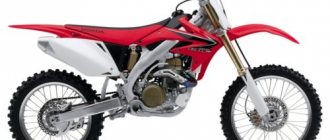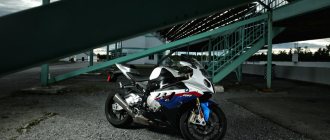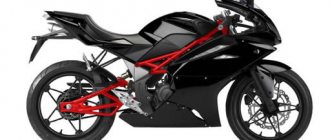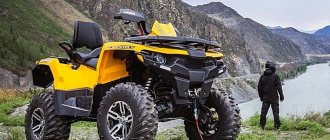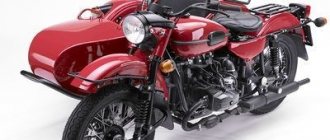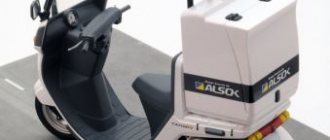The S2-250 MS-98S motorcycle is available in all motorcycle clubs in the country. The serial CZ -250 engine has a power of 25-27 hp. s., and improved engines of the factory’s branded racers - 32 hp. With. It's all about individual engine tuning. The main attention should be paid to the engine cylinder (Fig. 94).
It is necessary to carry out control measurements of the valve timing, the areas of the flow sections of the channels (especially inlet and purge), as well as the condition
piston rings, piston, cylinder liner, clearances in them. The discrepancy between the cross-sectional areas of the intake channels and the cross-sections of the windows on the cylinder liner is eliminated by sawing these places (Fig. 95), tracing the channel along the entire length using a template.
It is necessary to check the beginning of the opening of the inlet window (105 mm from the height of the m.t.). If the size does not match, trim to the required size. Next (without loosening the cylinder), you need to check the cross-sections of the purge channels - they should be the same. The metal is removed in the central part of the channel and at its curvature along a radius of 20 mm. It is advisable to smoothly adjust the transitions from the cylinder jacket to the window in the sleeve. The exit edge of the purge window must be polished with emery cloth. The purge phase does not change.
To release superheated gases from under the piston, you need to lower the window of the third channel down by 18 mm; Make a 12 x 12 mm hole in the piston opposite this window (Fig. 96).
After this boost, the bearing of the upper head of the connecting rod no longer turns blue, which indicates its good lubrication and cooling. In addition, the performance of the piston and piston rings improves due to the abundance of lubrication. In general, the purging is improved due to the additional portion of the mixture removed from under the piston into the cylinder. The height of the outlet window and the channel configuration also require changes.
The height of the window can be changed by sawing the window up to 33 mm from h. m.t., and the shape of the outlet window must be traced along the contour of the window with a smooth transition into the circular cross-section of the pipe and then polish the channel. This part of the exhaust port is of great importance in the operation of the engine, improving the processes of exhaust and cylinder refueling. Having changed the exhaust phase, it is necessary to change the compression ratio in the cylinder head by trimming the cylinder head by 1 mm. To the number of changes should be added a change in the length of the exhaust pipe. The exhaust pipe should be shortened by 100 mm, cutting off its end entering the muffler. The muffler should be moved forward, and the mounting brackets should be welded to a new location. At this point you can finish boosting the CZ engine. But if there is a desire to have a more powerful engine, work on the engine should be continued. The engine crankcase must be disassembled, the main bearings of the crankshaft must be knocked out, laps must be made and, using them, the internal dimensions of the bearings must be brought to a diameter of 25+ 0.01, the same should be done
and with gearbox bearings. To adjust the sliding fit of the main bearings to the outer size, a lap should also be made. Using a grinding machine, bring the outer size of the bearings to a smooth fit in the engine crankcase. A floating fit of the crankshaft in the main bearings will reduce mechanical losses in the engine. After assembling the engine, without seals, the rotation of the crankshaft and gearbox shafts should be very easy. The fit of the seals also requires attention. The difference between the diameters of the working state of oil seals with a diameter of 25 mm and the free state of the oil seal should be 0.8 mm (i.e., a diameter size of 24.2 mm). This can be achieved by loosening the tension of the oil seal spring (by stretching it) and polishing the crankshaft journals.
The assembled engine is installed in the motorcycle frame, spindle oil (0.8 l) is poured into the gearbox.
The ignition timing should be set according to the factory recommendations, within 2.7-2.8 mm before c. m.t.
You need to use AI-98 “Extra” gasoline and MS-20 oil. Oil is poured in a ratio of 1:25.
If possible, instead of the factory IKOV carburetor, install a domestically produced K-194 carburetor with a diffuser diameter of 32 mm. This
will improve the cleanliness of the engine and increase its maximum speed. After tuning and adjustment, the engine will have a maximum power of at least 30 hp. With.
ENGINES UP TO 350 cm 3 CLASS
Work carried out at VNIIMotoprom to increase the power of the IZH-350 Planet engine.
The power of mass-produced IZH-350 "Planet-2" engines can be increased to 20.5 liters. With. Engine technical characteristics: cylinder diameter 72mm, piston stroke
85 mm, cylinder displacement 346 cm 3, compression ratio 6.5, engine power 14.8 liters. With. Ignition timing (optimal) 3.6mm to c. m.t. Candle A-5U.
A number of works should be carried out to increase engine power: remove the side flats on the piston (Fig. 97).
This will give a power increase of 0.8 liters. s., and the engine will have a power of 15.7 hp. With.;
change the shape of the combustion chamber (Fig. 98) to an offset hemispherical one with a displacer, which will add another 0.5 liters. With. at the same compression ratio. Engine power will become 16.2 liters. With; bore the diameter of the carburetor diffuser to 27 mm (Fig. 99), which will facilitate engine operation and give an increase in power of 1.1 liters. With.
This review will focus on a motorcycle that was very popular during the Soviet Union, as well as beyond its borders. The CZ 350 motorcycle (Chezet 350) is a cult bike, which is characterized as reliable transport. The world recognized the Czechoslovakian manufacturer as a reliable supplier of motorcycles, after famous victories in such disciplines as Enduro and Motocross. But, Chezet 350 was rightfully considered a touring motorcycle. It was this unit that made it possible for tourists of that time to discover new horizons.
Production of the CZ 350 type 472.5 began in 1981. The model immediately became relevant among Soviet youth and beyond. This model had noticeable differences from its predecessors, which will be discussed later in the article. The distinctive advantages of the motorcycle are its dynamic performance element and sensitive control system. To appreciate the design of the bike, you need to look at the photo of the Cheset motorcycle. Let's look at the main technical aspects of the motorcycle.
Cheset 350: technical characteristics
The main power plant is a two-stroke engine with 2 cylinders. The cylinder arrangement is in-line. The working volume is 343 cc. At the same time, the motor is capable of producing 22 hp. The Port control function was used as a distribution system. The engine receives the necessary cooling due to the oncoming air flow.
The transmission consists of 4 gears. The main transmission is a metal chain. Drum brakes are installed at the front and rear of the motorcycle. Front and rear wheel sizes respectively: 3.25-18 and 3.50-18. The fuel tank is designed for 18 liters of fuel. The motorcycle is capable of reaching a maximum speed of 125 km/h.
Chezet motocross motorcycles
In Soviet times, Chezet cross-country motorcycles were well known to motorcycle racers in our country. Many motorcycle clubs and DOSSAF branches had such equipment on their balance sheet. These motorcycles were imported to our country from Czechoslovakia, where the CZ plant, along with road motorcycles, also produced sports motorcycles, in particular for motocross. Not only Soviet racers raced on the cars of this company; they were also known to athletes from Eastern Europe, Austria and even the USA.
There are several international classes for motocross, differing in engine size; the Chezet factories produced three of them: 125, 250 and 500 cm3. The factory indexes of these models were “984”, “980” and “981” respectively. The 984 motocross motorcycle began production in 1970. All these models have similar designs and appearance, which makes them indistinguishable to an inexperienced viewer. There are variations of the 980 and 981 models designed for long-distance motocross. These are real enduro bikes. Unlike the purely cross-country version, they have a headlight, an effective engine noise suppression system and a five-speed gearbox. Long-distance motocross racing on such motorcycles was very popular in the United States. All Chezet motocross motorcycles were equipped with two-stroke single-cylinder engines. Aluminum cylinder with cast iron sleeve. The cylinder purge is three-channel with one outlet window. Two spark plugs per cylinder with Magdino ignition. The clutch is multi-plate dry. Connecting rod heads, large and small, on needle bearings.
The frame is tubular, single under the saddle and bifurcated under the engine. On all three motorcycles, the front wheels are equipped with 2.75-21 tires. Rear wheels with tires 4.00-18, except for the 984 model - it has tire sizes 3.50-18.
In addition to serial motocross motorcycles, Cheset produced a limited number of special machines that were intended for factory racers. They competed in them at important high-level competitions, for example at the World Championships. They were significantly more powerful, faster and lighter than production models. However, at the same time it is also much more expensive. Special Chezet with an engine capacity of 250 cm3. was equipped with a five-speed gearbox, a carburetor with a central float chamber and transistor ignition. Cheset has titanium front fork stays and duralumin wheel rims. All this allowed me to reduce my weight to 95 kilograms. The engine power was raised to 37 horsepower at 7000 rpm.
| Type | |||
| 984 | 980 | 981 | |
| Options | |||
| Cylinder diameter and piston stroke, mm | 55×52 | 70×64 | 82x72 |
| Working volume, cm3 | 123 | 247 | 383 |
| Compression ratio | 13 | 10,5 | 10,5 |
| Power, l. With. | 19 | 29 | 42 |
| RPM | 7800 | 6900 | 6800 |
| Number of gears | 5 | 4 | 4 |
| Front brake drum diameter, mm | 160 | 180 | 180 |
| rear, mm | 180 | 180 | 180 |
| Dry weight, kg | 95 | 103 | 106 |
Main differences from previous models
- Spacious fuel tank.
- Upgraded telescopic forks at the front (with black boots).
- Installed safety bars.
- Improved seat.
- Large headlight.
Models type 472.3 and 472.4 were equipped with small-volume gas tanks, which caused a lot of outrage among buyers. These tanks were suitable for sports motorcycles, but not for touring ones. From an ergonomic point of view, the shape of the tank was also unsuitable. The rear part of the tank was wide and caused inconvenience to the owner of the equipment in operation. The upgraded gas tank is designed for 18 liters of gasoline. Its shape has been changed, making travel more comfortable. Regardless of the driver’s configuration, sitting on the motorcycle does not cause discomfort.
Don’t forget about the telescopic fork at the front, which has undergone some changes. The lower pipes are made of light alloy, which in turn only had a positive effect on the price of the fork. Regardless of the operating conditions of the motorcycle, the fork works well both on small uneven surfaces and deep holes, bumps and potholes. In addition, travel has become safer. The fact is that it is very difficult to bring the fork to the bottom, dead-end position. Well, let us remind you about the new rubber covers on the fork, which prevent dust from getting into the middle of the fork. Due to this, the fork will serve for many years.
Technical characteristics of chezet 513 250. Cross CEZET. Main differences from previous models
CORRECT BREAK-IN IS THE KEY TO DURABILITY IN A COLD ENGINE WITH INTENSIVE WEAR HIGH SPEED - IT IS EASIER TO MAINTAIN THE ENGINE - YOU REPAIR LESSLY When purchasing a motorcycle of a new brand, a person is naturally interested in everything that concerns this machine. What should you pay attention to when running in, what are the features of driving and maintenance, what is the durability of the main components and assemblies, etc.? These questions are often found in letters from readers. The answers to them are contained in the material published here about the Jawa-350, but much of it is also true for other motorcycles with a two-stroke engine (Voskhod, IZH, etc.). It was prepared by an experienced motorcyclist, consultant to the magazine, engineer E. Konop. We started operating the Jawa-350 type 634 model 8-00 four years ago, rode in a wide variety of conditions, under various loads, in all imaginable modes. Then, in the spring of 1977, the JAVA we took out of the box was no different from the many others that were in my mother’s yard...
The S2-250 MS-98S motorcycle is available in all motorcycle clubs in the country. The serial CZ -250 engine has a power of 25-27 hp. s., and improved engines of the factory’s branded racers - 32 hp. With. It's all about individual engine tuning. The main attention should be paid to the engine cylinder (Fig. 94).
It is necessary to carry out control measurements of the valve timing, the areas of the flow sections of the channels (especially inlet and purge), as well as the condition
piston rings, piston, cylinder liner, clearances in them. The discrepancy between the cross-sectional areas of the intake channels and the cross-sections of the windows on the cylinder liner is eliminated by sawing these places (Fig. 95), tracing the channel along the entire length using a template.
It is necessary to check the beginning of the opening of the inlet window (105 mm from the height of the m.t.). If the size does not match, trim to the required size. Next (without loosening the cylinder), you need to check the cross-sections of the purge channels - they should be the same. The metal is removed in the central part of the channel and at its curvature along a radius of 20 mm. It is advisable to smoothly adjust the transitions from the cylinder jacket to the window in the sleeve. The exit edge of the purge window must be polished with emery cloth. The purge phase does not change.
To release superheated gases from under the piston, you need to lower the window of the third channel down by 18 mm; Make a 12 x 12 mm hole in the piston opposite this window (Fig. 96).
After this boost, the bearing of the upper head of the connecting rod no longer turns blue, which indicates its good lubrication and cooling. In addition, the performance of the piston and piston rings improves due to the abundance of lubrication. In general, the purging is improved due to the additional portion of the mixture removed from under the piston into the cylinder. The height of the outlet window and the channel configuration also require changes.
The height of the window can be changed by sawing the window up to 33 mm from h. m.t., and the shape of the outlet window must be traced along the contour of the window with a smooth transition into the circular cross-section of the pipe and then polish the channel. This part of the exhaust port is of great importance in the operation of the engine, improving the processes of exhaust and cylinder refueling. Having changed the exhaust phase, it is necessary to change the compression ratio in the cylinder head by trimming the cylinder head by 1 mm. To the number of changes should be added a change in the length of the exhaust pipe. The exhaust pipe should be shortened by 100 mm, cutting off its end entering the muffler. The muffler should be moved forward, and the mounting brackets should be welded to a new location. At this point you can finish boosting the CZ engine. But if there is a desire to have a more powerful engine, work on the engine should be continued. The engine crankcase must be disassembled, the main bearings of the crankshaft must be knocked out, laps must be made and, using them, the internal dimensions of the bearings must be brought to a diameter of 25+ 0.01, the same should be done
and with gearbox bearings. To adjust the sliding fit of the main bearings to the outer size, a lap should also be made. Using a grinding machine, bring the outer size of the bearings to a smooth fit in the engine crankcase. A floating fit of the crankshaft in the main bearings will reduce mechanical losses in the engine. After assembling the engine, without seals, the rotation of the crankshaft and gearbox shafts should be very easy. The fit of the seals also requires attention. The difference between the diameters of the working state of oil seals with a diameter of 25 mm and the free state of the oil seal should be 0.8 mm (i.e., a diameter size of 24.2 mm). This can be achieved by loosening the tension of the oil seal spring (by stretching it) and polishing the crankshaft journals.
The assembled engine is installed in the motorcycle frame, spindle oil (0.8 l) is poured into the gearbox.
The ignition timing should be set according to the factory recommendations, within 2.7-2.8 mm before c. m.t.
You need to use AI-98 “Extra” gasoline and MS-20 oil. Oil is poured in a ratio of 1:25.
If possible, instead of the factory IKOV carburetor, install a domestically produced K-194 carburetor with a diffuser diameter of 32 mm. This
will improve the cleanliness of the engine and increase its maximum speed. After tuning and adjustment, the engine will have a maximum power of at least 30 hp. With.
ENGINES UP TO 350 cm 3 CLASS
Work carried out at VNIIMotoprom to increase the power of the IZH-350 Planet engine.
The power of mass-produced IZH-350 "Planet-2" engines can be increased to 20.5 liters. With. Engine technical characteristics: cylinder diameter 72mm, piston stroke
85 mm, cylinder displacement 346 cm 3, compression ratio 6.5, engine power 14.8 liters. With. Ignition timing (optimal) 3.6mm to c. m.t. Candle A-5U.
A number of works should be carried out to increase engine power: remove the side flats on the piston (Fig. 97).
This will give a power increase of 0.8 liters. s., and the engine will have a power of 15.7 hp. With.;
change the shape of the combustion chamber (Fig. 98) to an offset hemispherical one with a displacer, which will add another 0.5 liters. With. at the same compression ratio. Engine power will become 16.2 liters. With; bore the diameter of the carburetor diffuser to 27 mm (Fig. 99), which will facilitate engine operation and give an increase in power of 1.1 liters. With.
Soviet riders are very familiar with the Cheset-980 motorcycles, which are in service with many sports clubs.
The Czechoslovakian production program, along with road motorcycles of the 125 and 175 cm3 classes, also includes sports motorcycles intended for cross-country motorcycles. These machines are the most widely known. Many racers from the Soviet Union, East Germany, Poland, Austria, Belgium, the USA and other countries compete at them. To meet the demand of the export market, the company had to sharply increase the production of motocross cars. If in 1970 2,000 of them came out of the factory in Strakonice, then in 1971 there were already 5,000. This year it is planned to produce more than 8,000 cross-country “chesets” of different models. Today the company produces machines of three international classes: 125, 250 and 500 cm3. These models have “980” and “981” respectively. They are all quite similar in design, and the last two are even difficult to distinguish at first glance.
All three motorcycles are equipped with single-cylinder two-stroke engines. The aluminum cylinder with a cast iron liner has a three-channel purge and one outlet window. There are needle bearings in the large and small heads of the connecting rod. Ignition is from Magdino with two spark plugs per cylinder. Through two helical gears and a multi-plate dry clutch, torque is transmitted to the gearbox.
The power unit is mounted in a single closed tubular frame, which bifurcates under the engine and below the saddle. The front wheels are equipped with 2.75-21 tires on all three models. and the rear tires are 4.00-18 (for the “984” model - 3.50-18).
Last year at the fair in Brno he demonstrated two varieties of models “980” and “981”, which he called Enduro. They are intended for long-distance cross-country races, which are often held in the USA. Unlike the main models, the Chezet Enduro has a five-speed gearbox, a conventional lighting system and a more efficient exhaust silencer. The speed of a car with a 250 cc engine is 140 km/h, and with a 400 cc engine it is 155 km/h.
For factory riders competing in important competitions such as the World Championship. “Chezet” makes several special machines based on serial motocross motorcycles, the data of which is given in the table. They are more powerful, lighter, faster than production models, but much more expensive. This “Chezet” of the 250 cm3 class is equipped with transistor ignition, a carburetor with a central float chamber, and a five-speed gearbox. Engine power increased to 37 hp. With. at 7000 rpm, and the weight is reduced to 95 kg. The 500 cm3 class motorcycle (like the 250 cm3) has titanium front fork stays and duralumin wheel rims, which reduces its weight to 103 kg. Engine power is about 44 hp. With.

